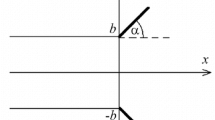Abstract
We propose a new model of deformation of a body containing a disk-shaped slot (mathematical cut). According to this model, the physical boundary of the body within the limits of the slot is regarded as a boundary layer whose thickness is equal to zero. The rheological properties of this layer guarantee the validity of the physical condition of continuity of the components of the vector of local rigid rotation Ω = 0.5 rot u on the boundary and, hence, its smooth deformation (without fracture). The model is applied to the statement of the classical problem of elastic equilibrium of a mode-I disk-shaped slot. The set of stress-strain states caused by the properties of the boundary layer formed on the surfaces of the slot is found by the method of discontinuous Weber-Schafheitlin integrals. It is proved that physically meaningful stress-strain states exist only in the presence of a jump of tangential stresses on the surfaces of the slot (in passing across the slot). If the vector Ω is continuous in the front of the slot, then the indicated jump can be continued in its plane and forms a surface of discontinuity of tangential stresses (discontinuity surface of the first order) in the continuous body. In the absence of a jump of this sort on the surfaces of the slot (outside the slot, it exists), these surfaces form a kink of its front characterized by the logarithmic singularity of bulk strains in the case of continuous distribution of normal stresses in the plane of the slot. If a jump of tangential stresses in the plane of the slot is absent, then the front of the slot turns into an ellipse and the stress-strain state possesses a square-root singularity of stresses.
Similar content being viewed by others
REFERENCES
R. A. Sack, “Extension of Griffith’s theory of rupture to three dimensions,” Proc. Soc., 58, 729–736 (1946).
M. Ya. Leonov and V. V. Panasyuk, “Propagation of a circular (in plan) crack,” Dop. Akad. Nauk Ukr. RSR, No. 2, 165–168 (1961).
V. V. Panasyuk, Mechanics of Quasibrittle Fracture [in Russian], Naukova Dumka, Kiev (1991).
V. A. Halazyuk and H. T. Sulym, “Nonclassical mathematical model of deformation of an elastic half space containing a thin disk-shaped perfectly rigid inclusion,” Visn. Donetsk Univ., Ser. A, Pryrod. Nauk., Issue 1, 77–82 (2002).
V. A. Galazyuk and G. T. Sulim, “Nonclassical model of deformation of cracked bodies,” Teor. Prikl. Mekh., Issue 33, 63–75 (2001).
L. I. Sedov, Continuum Mechanics [in Russian], Vol. 1, Nauka, Moscow (1970).
C. Truesdell, A First Course in Rational Continuum Mechanics, John Hopkins University, Baltimore, Maryland (1972).
L. Schwartz, Méthodes Mathématiques Pour les Sciences Physiques, Hermann, Paris (1961).
M. Abramowitz and I. A. Stegun (editors), Handbook of Mathematical Functions with Formulas, Graphs, and Mathematical Tables, National Bureau of Standards, Appl. Math., Ser. 55 (1964).
I. S. Gradshtein and I. M. Ryzhik, Tables of Integrals, Sums, Series, and Products [in Russian], Fizmatgiz, Moscow (1963).
Author information
Authors and Affiliations
Additional information
Translated from Fizyko-Khimichna Mekhanika Materialiv, Vol. 40, No. 4, pp. 17–33, July–August, 2004.
Rights and permissions
About this article
Cite this article
Halazyuk, V.A., Sulym, H.T. Equilibrium of a disk-shaped slot with regard for the rheological properties of the surface layer. Mater Sci 40, 446–465 (2004). https://doi.org/10.1007/s11003-005-0062-5
Received:
Issue Date:
DOI: https://doi.org/10.1007/s11003-005-0062-5




